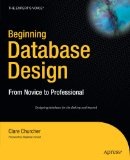 I wanted to take some time and go back to some database basics so I looked for some introductory books on database design. I decided on Beginning Database Design From Novice to Professional by Clare Churcher. This is a well written book with decent examples but a bit too introductory for a database programmer. I think it would be a very good book for someone who is looking to move from spreadsheets into databases though.
I wanted to take some time and go back to some database basics so I looked for some introductory books on database design. I decided on Beginning Database Design From Novice to Professional by Clare Churcher. This is a well written book with decent examples but a bit too introductory for a database programmer. I think it would be a very good book for someone who is looking to move from spreadsheets into databases though.
The book is relatively short at 240 pages. It contains twelve chapters along with a conclusion and index. It is truly aimed at the casual computer user who has a need to track data. Most of the examples pertain to education and research. Each of the examples are well thought out and clearly demonstrate the concepts she is discussing.
I thought her approach to introducing the material was well organized. She made some excellent points in her first chapter "What can go wrong", it demonstrated the importance of good design quickly. Chapter 2 is a brief introduction into the development process. I was happy to see some discussion of use cases in this chapter. I think this is a very important step in the design and development process.
Chapter 3 examines use cases more thoroughly showing how the process of working with the users and identifying how they will use the data is a fundamental requirement for designing a good database. Chapters 4 and 5 dive into creating a data model. This includes considerations of data types and logical grouping of data. These chapters also spend a lot of time discussing data relationships.
Chapters 6 discusses looking at data as classes. This provides a good way to demonstrate when it is appropriate to create subclasses that have some common data but also include specific information of their own. Chapters 7 through 9 discuss the relational database model. This is where all of the concepts introduced in the first half of the book come together. There is a lot of discussion about primary keys, normalization and constraints. Each of these concepts include simple and effective examples.
Chapter 10 is a very quick overview of SQL queries. It demonstrates how to create simple queries to get the data out of the database. If you have worked with SQL before you won't see anything new here. Chapter 11 discusses some user interface issues. I liked how she brought the UI design back to the use cases she discussed in the beginning of the book. All of the UI examples were done in MS Access and are very simple.
The book concludes with some discussion of object-oriented databases and using data within a spreadsheet. Probably very useful for a casual computer user but not something a programmer really needs. The conclusion does a good job of summarizing the material in the book as well as offering recommendations for more information.
The bottom line: this book is well written for its intended audience casual users to possibly IT professionals. As a database programmer you will want to invest in something more focused on a programmer's prospective.



No comments:
Post a Comment